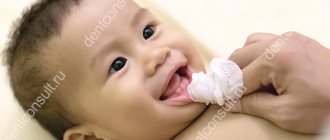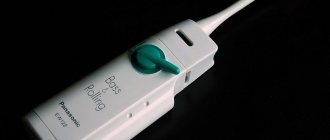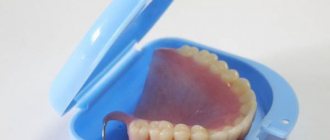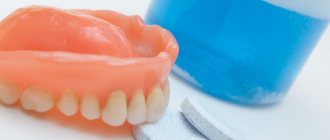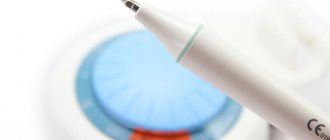At what age can you start brushing your teeth?
Parents need to start taking care of their child’s oral hygiene even before the first teeth appear. Even completely bare mucous membranes are a favorable environment for the growth of bacteria. Before the age of six months, it is, of course, too early to use a brush. But in this case, you can resort to clean gauze soaked in boiled water at room temperature and wrapped around your finger. This is a suitable option to carefully treat the mucous membrane and remove plaque.
Clean gauze should be used before teething
With the appearance of the first primary incisors at 6-7 months of age, you should continue to clean soft and hard tissues using gauze. But you can now switch to a special silicone fingertip - it is also designed for gentle treatment of gums, tongue and the first strong teeth. You need to perform the procedure twice a day - just like with standard cleaning in adulthood.
The next stage usually begins at the age of 1 year. At this time, you can already move on to the first brush, but cleaning should be carried out under close parental supervision. Starting from 3 years of age, the child should be able to carry out the procedure independently.
How to teach a child to brush their teeth
Many children under 1 year old, and sometimes older children, do not want to brush their teeth, expressing their dissatisfaction in every possible way. In this case, it is necessary to attract their attention to the hygiene procedure using one of the following methods:
- buy a bright brush with your favorite cartoon character and toothpaste with a pleasant fruity taste;
- invite your child to brush the teeth of his toys;
- brush your teeth with your child and compete with him in the quality and speed of brushing.
Each parent independently decides at what age to start brushing their child’s teeth and whether to use toothpaste, but delay can negatively affect the baby’s health. Parents should not only brush their children’s teeth, but also teach them how to properly care for their mouth on their own.
Dr. Komarovsky talks in more detail about children’s teeth, caring for them and teaching a child to brush:
Features of oral care during teething
The timing of the eruption of the first milk teeth is individual for each baby. Usually this process begins between 4 and 7 months, and for some, only in the first year of life. This is a delicate period that requires increased attention to the condition of the oral cavity. Experts in pediatric dentistry provide several specific recommendations in this regard:
- Excess salivary fluid must be systematically removed to prevent irritation around the mouth. To do this, you can use a clean napkin or the edge of a towel,
- It is recommended to give the baby special teethers, you can buy these at the pharmacy,
- You should not use teethers with liquid inside - there is always a risk that they will burst. You should also not refrigerate them in the freezer, as this can cause injury to your gums. It is enough for the teether to lie in the refrigerator for only 15 minutes,
- a light massage of the gums with a clean finger has worked well,
- Every time after feeding, the gums should be wiped with gauze soaked in boiled water at room temperature. Some experts allow the use of special anti-inflammatory solutions, but it is better to consult with your pediatric dentist in person on this matter.
Teethers will help ease the baby's teething process.
“My son is 1.5 years old, but the pediatrician is categorically against any brushes until he is two years old. He says there is nothing to clean there, just use a fingertip. In addition, this procedure will be too traumatic for him, and the enamel can be accidentally damaged. So I just clean my tongue with a bandage soaked in water, and my teeth separately with a fingertip.”
Ekaterina F., from correspondence on the woman.ru forum
During the period of formation of the primary occlusion, the child’s body weakens, and a slight, but still, decrease in local immunity occurs. This means that it is at this time that the baby is at greater risk of contracting an infection. The gums are already inflamed, so you should not carry out additional manipulations too often and intensively. Care should be as gentle as possible, but attentive and regular.
The best mechanical toothbrushes for children
Most people use mechanical (manual) toothbrushes because they are more familiar and cheaper than electric ones. Doctors say that the former are less effective than the latter, but they cannot definitely be called useless. To accustom your child to hygiene, standard models are also suitable. The rating of manual toothbrushes for children can include:
- CURAPROX Curakid.
- CURAPROX CS 7600 Smart.
- CURAPROX ATA.
Other manufacturers also produce children's toothbrushes. We invite you to familiarize yourself with the models that are approved by dentists and are in demand among our customers.
CURAPROX Curakid
Toothbrush for children under 4 years old. Available in 3 colors: blue, green and pink. The handle is rubberized, the bristles are soft but elastic, and therefore cope well with plaque. The convenient height of the hairs allows you to brush your teeth in remote areas.
pros
- comfortable to hold in hand;
- attractive design.
Minuses
- no protective cap;
- wide base.
CURAPROX CS 7600 Smart
Children's toothbrush for children 5-7 years old. The size of the head is small, but there are quite a lot of bristles on it, they cover two teeth. The hairs are very thin - 0.08 mm in diameter and soft, and therefore safe for the child. The brush is made of harmless plastic.
pros
- available in several color options;
- Effectively cleans teeth without damaging the gums.
Minuses
- there is no protective cap;
- relatively high price.
CURAPROX ATA
Toothbrush for children 8-14 years old. It has a textured handle that does not slip out of your hand. The base is made of hygienically safe polypropylene.
pros
- comfortable handle;
- soft but elastic bristles;
- comfortable head shape.
Minuses
- no cap;
- is relatively expensive.
Now let's look at electric toothbrushes for children.
First toothbrush – before and after one year
As mentioned above, each stage of growing up requires its own oral care. The following are the basic principles of maintaining hygiene in childhood:
- up to 1 year - clean the gums with gauze soaked in boiled water at room temperature, and also use silicone fingertips for more thorough cleaning of the first teeth that appear,
- after 1 year - continue to use finger pads and gradually switch to a baby brush with rubber bristles and a limiter on the handle that prevents tissue injury,
- with the appearance of incisors, canines and molars, you can begin to use a full-fledged model, but taking into account children's age, therefore with a small head and soft bristles.
You can rely on the age markings on the packaging, but most often they are too vague. Therefore, it is better to choose a model individually, according to the recommendations of the observing pediatric dentist.
Which brushes are suitable for children: selection criteria
When buying toothbrushes for children, pay attention to the following points:
- Age. For a one-year-old baby who is just teething, a toothbrush designed for children 5-7 years old will not work. The packaging must indicate who the hygiene product is intended for. Different models differ in size and other parameters.
- The stiffness of the bristles. It can be soft, hard and medium hard. On some products you can see the description “ultra-soft”, but most likely the bristles of the brush are just soft. It is better for children to choose just such models so that they do not injure their gums. Also, look at how many rows of bristles there are on the head. There should be at least 4 of them. Their height is usually 1.1 cm. If the bristles are located at the same level, the brush is suitable for cleaning baby teeth. After the molars appear, you can switch to another model - with hairs of different lengths.
- Head size. The bristles should not cover more than two teeth. For children under 2 years old, toothbrushes with a head size of 1.5 cm are suitable, for 5-year-olds - with a diameter of 2 cm, for 7-year-olds - up to 2.5 cm. The number of tufts should not exceed 55 pieces.
- Handle size. If a child finds it uncomfortable to hold a toothbrush in his hand, he will not be able to brush his teeth properly. Choose models with rubberized handles that do not slip. Children's brushes should be the following lengths: 10 cm for 2-year-olds, 15 cm for 5-year-olds, 17 cm for 7-year-olds.
- Design. Today you can buy not only high-quality and functional, but also beautiful children's toothbrushes. There are models in bright colors, with stickers and stylized as cartoon characters. To quickly accustom your baby to brushing his teeth, you need to turn the hygiene procedure into a game.
A factor such as price is not decisive. However, practice shows that cheap toothbrushes quickly become unusable. Plus they are uncomfortable. Dentists recommend not saving on oral hygiene products, since dental treatment is much more expensive. Now let's present a rating of children's toothbrushes and find out which one is better.
Finger tip for cleaning gums and first teeth
It was already mentioned above that the first “brush” for a child should be a fingertip. Essentially, it is a small silicone cap that is designed to be placed on mom's finger. Cleaning with it is carried out according to the same principle as with a piece of gauze. This is a special device that does not injure children’s delicate gums, but provides a beneficial massage and improves blood circulation in soft tissues. Recommended age for use is 6-10 months.
With the appearance of the first teeth, you can use special silicone finger guards
It is important to consider that such a fingertip needs to be updated every 1-2 months. At the slightest sign of damage to the integrity of the brush, it must be urgently replaced with a new one. The cleaning procedure itself should take about 4-5 minutes.
What it is?
Keep in mind! Dentists recommend that parents start caring for their teeth when they have little or no teeth.
Because it’s not only about cleaning, but also about teaching the baby a very important hygiene procedure . Therefore, it is very important that training is timely.
In addition, it is much easier to accustom a small child to a toothbrush at a time when he “tastes” everything and puts it in his mouth.
It is best for a small child to purchase a silicone massage brush , which will become his first toothbrush.
It is also called a fingertip. This is a transparent cap, at the end of which there is a large amount of short fibers and pimples made of silicone .
Its peculiarity is that before use the product must be placed on the index finger of an adult.
It is also allowed to be worn on the little finger.
For your information! Thanks to this simple thing, you can not only gently remove plaque from the baby’s first teeth, but also massage his gums, which is done due to the presence of villi and pimples.
Moreover, most kids like this procedure.
Parents
need to remember that the mouth of a small child must be regularly cleaned of food debris and microbial plaque.
In addition, milk teeth are a favorable and nutritious environment for fungal flora, as well as for the development of candidal stomatitis.
Many parents are also attracted by the low price of the product.
Very often a special case comes with it.
Note! If the child is 3-4 months old, then you can start using the finger brush.
This product has the following advantages :
- hygienic care of the item is quite easy;
- it contains absolutely no harmful substances ;
- provides a massage effect ;
- Since it is made of soft material, it is almost impossible to injure the child’s gums.
Stay up to date! In addition to its advantages, the brush also has disadvantages:
- short service life . Very often, when little children start teething, they start to itch, so the baby can simply chew on the device;
- The size of the silicone brush is more designed for women's fingers , but it may not fit on men's fingers;
- It often happens that a child bites the brush , naturally, with a finger inside it, so parents need to be careful .
How to choose a brush for a child - main characteristics
A product for the first teeth should not only be bright and attractive. It must meet a number of important criteria, and here are the main ones:
- the product must be made of high-quality plastic - be sure to check for a certificate,
- For the first years, soft or ultra-soft bristles are suitable. You can switch to medium hardness from the age of three,
- give preference to synthetic bristles, as they are more wear-resistant and do not create a favorable environment for the growth of bacteria. Natural bristles are a real breeding ground for harmful microorganisms, and regular disinfection quickly renders the product unusable. The best option during the “teeth to teeth” period is silicone bristles,
- for babies older than one year, the length of the pile should be about 11 mm, let’s say a multi-level option with a V-shaped arrangement of synthetic bristles,
- The handle must have rubberized anti-slip elements. From the age of 2-5 years, the length of the handle can reach 15 cm. It is desirable that there is a flexible connection between the base and the head,
- the head size should not exceed 15 mm - for the smallest. From the age of 2, its length can reach 20 mm, and its shape must be smooth and streamlined1,
- It is desirable that there is a rubberized ribbed surface on the back of the working area - it is designed to clean the tongue.
Be careful when choosing a children's toothbrush.
As for the appearance and design, everything depends on the preferences of the parents and the baby. The modern assortment offers the widest variety for every taste and color.
Is sterilization necessary?
Recently, devices for sterilizing children's toothbrushes have appeared on the market, which provide antibacterial treatment using steam.
Sterilizers can be used not only for children's brushes, but also for regular ones.
Experts consider the use of sterilizers inappropriate for several reasons:
- The service life of a children's toothbrush is about 2-3 months. After this, it must be replaced, since such a brush loses its hygienic and consumer properties.
- All modern products are made from synthetic materials in which the growth of pathogenic flora is practically impossible. To ensure hygienic treatment and remove bacteria from the surface of the product, it is enough to wash it with warm water and soap.
- Steam treatment can lead to deterioration of the silicone properties and faster deformation of the product.
Review of the best brands - for children under 3 years of age and older
Below is a rating of the best manufacturers of children's toothbrushes, based on expert recommendations and reviews from parents on the Internet. The table contains all the key information about brands that produce products for children under 3 years of age and older.
| Brand and country of origin | Characteristics and cost | Advantages and disadvantages |
| Canpol (Poland) | There are several models in stock. The Canpol babies silicone fingertip, which is ideal as a first tool for maintaining hygiene, costs about 140 rubles. There is also an option with a restrictor in the form of a ring, designed for ages from six months, costs about 200 rubles. | The fingertip has soft bristles that provide additional massage to the gums. The silicone model is characterized by increased softness of the bristles. Therefore, according to reviews, it does not always clean plaque and dirt thoroughly enough. |
| Happy Baby (UK) | Happy Baby Tooth care x3 kit with limiters, cost about 175 rubles. | Soft bristles and a protective ring, available in several models: in the form of a teether, a mucous massager and a full-fledged brush. |
| Pigeon (Japan) | Educational model for children from 10 months – 200 rubles. The range also includes a set for children from 18 months, the cost of which is about 400 rubles. | The training version, compact and convenient, designed just for a child’s hand, is equipped with a limiter. The set includes a double-sided model (from 6 to 8 months), a single-sided model (from 1 year), and a brush with a ring (from 1 to 3 years). |
| Mam (Switzerland) | The cost of a brush for mother and baby is 274 rubles. | The model is designed for ages from 6 months. Due to the special ergonomic design of the handle, the brush can be comfortably held by mother and child. Material: polypropene and silicone. |
| Oral-B (USA) | Battery operated model for ages 3 years and up. Cost – about 730 rubles. | Original design with a rubberized body, high cleaning efficiency due to circular rotation of the head, and a timer. Replacement heads are available for sale. |
| SILCA Putzi Baby (Germany) | For children over 1 year old, cost – 130 rubles. | Ergonomic rubberized handle, interesting design and soft bristles with good cleaning performance. |
Budget segment
Aquafresh My baby teeth
This product is designed for children aged three to five years, that is, they are already quite independent and are able to take care of themselves, including brushing their teeth. Available with bright caps made in the shape of animal heads. The brushes themselves are painted in eye-catching colors and different patterns, so kids will have fun caring for their teeth with these products.
More: TOP 5 best cereals for first feeding
The handle here is very comfortable; it consists almost entirely of rubber inserts, so it will not slip even in wet children’s fingers. There is a suction cup on the base - the brush does not have to be put away in a cup, but can simply be stuck on the wall or on the sink. The bristles here are very soft, made of silicone, and practically do not wear off during use.
Advantages:
- The original protective cap is provided;
- Very carefully cares for children's teeth and gums;
- Attractive appearance;
- The ergonomics of the handle and suction cup are carefully thought out.
Flaws:
- The product quite quickly loses its original appearance;
- Relatively rigid connection between head and handle.
Aquafresh toothbrush My baby teeth
Colgate SpongeBob
The first electric model in our review, powered by standard batteries or traditional AA batteries. Despite its quite reasonable cost, such a brush functions very effectively. It cleans teeth thoroughly and efficiently - removing much more plaque and pathogenic bacteria than a standard toothbrush. This device is equipped with a small vibrating head. Despite the fact that it rotates quite quickly, the enamel remains intact.
The bristles are made of soft rubber, which are at a slight angle to each other. The handle of the device is of high quality, its shape is carefully thought out, so the child can easily use it independently. These products are suitable for children aged 3 years and older.
Advantages:
- Very beautiful and bright design;
- Batteries are included with the toothbrush;
- Reasonable price.
Flaws:
- There is no battery charge indicator;
- There is only one nozzle, and it is not possible to change it if necessary;
- There is no automatic shutdown timer for the device.
Colgate SpongeBob Toothbrush
Bebe comfort
The set comes with two comfortable, interesting and not quite ordinary toothbrushes from a well-known French manufacturer. One product has bristles made of silicone, the other of ordinary materials. It is worth noting that the manufacturer recommends using such products also for teething. The product handle is made of rubberized materials and has an ergonomic shape. Thanks to this solution, the brush will not slip out even from wet hands, so the likelihood of injury to the oral cavity is reduced to almost zero.
The brushes are very ordinary, they do not contain any electrical elements, so they are prepared for use in the simplest way: boiled in water for several minutes. It is worth noting that this brush can be used starting from the age of three months.
Advantages:
- The set includes two easy-to-use brushes, and each of them has a case;
- Convenient and easy to sterilize;
- Can be used for teething;
- Safe and versatile in use.
Flaws:
- The bristles are quite hard.
Bebe confort toothbrush
BABYONO
In second place in this section of our review of the best toothbrushes for children is also a set presented with three accessories at once, each of which will correspond to a certain age of the child. Such a solution from the manufacturer will be a very convenient and practical purchase, since the baby’s parents will no longer have to constantly search for and purchase toothbrushes for a new stage of dental and oral care.
The set includes a special massager suitable for the period when the child is cutting his first teeth. It will also provide complete care for the baby's gums. The silicone brush for the first teeth is made from the safest materials that will not cause an allergic reaction or irritation. The bristles themselves are very soft. The third toothbrush is designed for effective and high-quality oral care in older age. The brushes are made in a variety of colors and are characterized by a comfortable handle.
More: TOP 11 + best remedies for colic in newborns
Advantages:
- The set contains the entire set of brushes that will be useful to the baby, starting literally from the moment of birth;
- The products are absolutely safe;
- Very comfortable handle.
Flaws:
- It is not found everywhere, although it is not very expensive.
BABYONO toothbrush
PresiDENT Kids-Junior
This brush is best suited for children aged 5 to 11 years; it is characterized by a very bright design and is intended exclusively for self-cleaning teeth, oral care, and so on. The handle is thick and has soft rubber inserts. On the front side you can find a slope for the thumb, on the back side there are waves for convenient placement of the remaining fingers. The head has a cone shape. The bristles are soft and graduated, made of high quality nylon, and have rounded tips.
The bristles here are divided into two bundles - upper and lower. The first one has small overall dimensions and is blue in color, the second one is larger and painted white. Both of these units are designed to thoroughly remove even the smallest food debris in the interdental spaces, effectively cleaning the back teeth. The weight of the product is only 25 grams with a length of 14.5 cm. A protective cap can also be found in the kit.
Advantages:
- Beautiful appearance that will be maintained throughout its entire service life;
- Carefully but thoroughly cares for teeth, gums and the entire oral cavity;
- Reasonable cost;
- Includes a cap for convenient storage;
- The handle will not slip in your palms.
Flaws:
- Not detected.
Toothbrush PresiDENT Kids-Junior
When can you start using electric models?
Experts in pediatric dentistry do not recommend purchasing electric toothbrushes for children under 2 years of age. In general, experts advise starting to use them no earlier than 5 years. In any case, it is impossible to use an electric model on an ongoing basis at an early age. The enamel of baby teeth is quite thin and fragile and can be easily damaged. Starting from 5-6 years old, you can begin to periodically use an electric model - the teeth should gradually get used to its effects.
An electric brush can be used from 5-6 years old
How to properly care for your first toothbrush
Modern children's models are not designed for intensive heat treatment. This means that they do not need to be doused with boiling water or boiled. They must be washed thoroughly with soap after each cleaning. It should be stored in a separate glass, with the bristles facing up. When purchasing a brush for a child, be sure to carefully read the instructions and care recommendations.
On a note! Many parents are interested in how to treat the product before first use. In fact, after unpacking the brush remains completely sterile and does not require any additional manipulations. Sometimes it is advised to pour boiling water over the bristles, but this will only help soften them a little to avoid injury to the gums.
Always consult your pediatric dentist about any hygiene products, including toothpastes. Only a doctor will be able to accurately assess the current condition of primary incisors and molars and, based on this, give correct recommendations for oral care.
1Borovsky E.V. Dental health is in our hands, 2004.
How to choose a product?
First of all, you need to pay attention to the material. It should be durable , but at the same time soft , so that the brush does not scratch or injure the baby’s sensitive gums.
You should know! Nowadays brushes are made of silicone.
Choosing the right thing is not so difficult, because all models are almost the same. They may vary in color and the presence of additional accessories.
It is recommended to buy those brushes that are sold with the case.
In this case, over time, when the brush deteriorates, it will be possible to purchase a new one, but without the case, since it was left over from the previous one.
Thanks to the container, the transparent fingertip is unlikely to get lost.
In most cases, all brushes are the same size.
It is recommended to buy the product in specialized stores , and even better - in pharmacies .
If the item was sold without a case, then it will need to be stored in a separate open cup. In this case, the end of the brush with bristles should be located at the top and “breathe”.
Know! A finger brush is also better than a traditional one because it can be replaced as it wears out.
